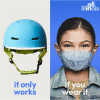Health communication in and out of public health emergencies: to persuade or to inform?
- PMID: 35248064
- PMCID: PMC8897761
- DOI: 10.1186/s12961-022-00828-z
Health communication in and out of public health emergencies: to persuade or to inform?
Abstract
Much health communication during the COVID-19 pandemic has been designed to persuade people more than to inform them. For example, messages like "masks save lives" are intended to compel people to wear face masks, not to enable them to make an informed decision about whether to wear a face mask or to understand the justification for a mask mandate. Both persuading people and informing them are reasonable goals for health communication. However, those goals can sometimes be in conflict. In this article, we discuss potential conflicts between seeking to persuade or to inform people, the use of spin to persuade people, the ethics of persuasion, and implications for health communication in the context of the pandemic and generally. Decisions to persuade people rather than enable them to make an informed choice may be justified, but the basis for those decisions should be transparent and the evidence should not be distorted. We suggest nine principles to guide decisions by health authorities about whether to try to persuade people.
Keywords: Ethics; Evidence-informed health policy; Health communication; Health education; Health information; Health promotion; Infodemic; Persuasion; Risk communication.
© 2022. The Author(s).
Conflict of interest statement
The authors declare that they have no competing interests.
Figures



Similar articles
-
Framework for Managing the COVID-19 Infodemic: Methods and Results of an Online, Crowdsourced WHO Technical Consultation.J Med Internet Res. 2020 Jun 26;22(6):e19659. doi: 10.2196/19659. J Med Internet Res. 2020. PMID: 32558655 Free PMC article.
-
Public Health Messages About Face Masks Early in the COVID-19 Pandemic: Perceptions of and Impacts on Canadians.J Community Health. 2021 Oct;46(5):903-912. doi: 10.1007/s10900-021-00971-8. Epub 2021 Feb 20. J Community Health. 2021. PMID: 33611755 Free PMC article.
-
Public Health and Risk Communication During COVID-19-Enhancing Psychological Needs to Promote Sustainable Behavior Change.Front Public Health. 2020 Oct 27;8:573397. doi: 10.3389/fpubh.2020.573397. eCollection 2020. Front Public Health. 2020. PMID: 33194973 Free PMC article.
-
Public participation in decisions about measures to manage the COVID-19 pandemic: a systematic review.BMJ Glob Health. 2024 Jun 3;9(6):e014404. doi: 10.1136/bmjgh-2023-014404. BMJ Glob Health. 2024. PMID: 38830748 Free PMC article.
-
The Impact of COVID-19 Pandemics on the Development of Health Risk Communication: Challenges and Opportunities.Int J Environ Res Public Health. 2022 Dec 30;20(1):645. doi: 10.3390/ijerph20010645. Int J Environ Res Public Health. 2022. PMID: 36612966 Free PMC article. Review.
Cited by
-
Improving COVID-19 vaccine uptake: a message co-design process for a national mHealth intervention in Colombia.Glob Health Action. 2023 Dec 31;16(1):2242670. doi: 10.1080/16549716.2023.2242670. Glob Health Action. 2023. PMID: 37643136 Free PMC article.
-
Reflections from the COVID-19 pandemic in Germany: lessons for global health.BMJ Glob Health. 2023 Sep;8(9):e013913. doi: 10.1136/bmjgh-2023-013913. BMJ Glob Health. 2023. PMID: 37748795 Free PMC article. No abstract available.
-
Transparent communication of evidence does not undermine public trust in evidence.PNAS Nexus. 2022 Dec 7;1(5):pgac280. doi: 10.1093/pnasnexus/pgac280. eCollection 2022 Nov. PNAS Nexus. 2022. PMID: 36712327 Free PMC article.
-
Determinants of COVID Vaccination Willingness among Health and Non-Health Studies Students: A Cross-Sectional Study.Vaccines (Basel). 2023 May 15;11(5):981. doi: 10.3390/vaccines11050981. Vaccines (Basel). 2023. PMID: 37243085 Free PMC article.
-
Rural adults' perceptions of nutrition recommendations for cancer prevention: Contradictory and conflicting messages.Prev Oncol Epidemiol. 2023;1(1):2237680. doi: 10.1080/28322134.2023.2237680. Epub 2023 Nov 17. Prev Oncol Epidemiol. 2023. PMID: 38390218 Free PMC article.
References
-
- Balog-Way DHP, McComas KA. Covid-19: reflections on trust, tradeoffs, and preparedness. J Risk Res. 2020;23(7–8):838–848.
-
- McCartney M, Sullivan F, Heneghan C. Information and rational decision-making: explanations to patients and citizens about personal risk of Covid-19. BMJ Evid Based Med. 2020;26:143. - PubMed
-
- Fischhoff B. The Covid communication breakdown. In: Foreign Affairs. 2021.
-
- Hyland K, Jiang F. The Covid infodemic: competition and the hyping of virus research. Int J Corpus Linguist. 2021;26:444.
Publication types
MeSH terms
LinkOut - more resources
Full Text Sources
Medical

